A FEAST OF FESTIVALS IN FRANCE
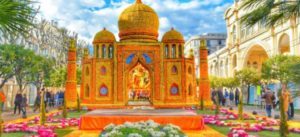
From history to fantasy, and everything in between, there are plenty of festivals in France where you can experience the country’s vibrant culture. These events celebrate everything from the latest movies, the medieval period, art, wine, parks & gardens, kites, lemons, and dragons, to theatre, opera, and other different genres of music. Right across the country, the biggest and most important festival in France is of course Bastille Day. However, if you want to make the most of your next trip to France, check out these festivals—by no means an exhaustive list—and start booking now.
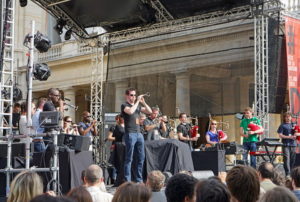
No matter what time of year you’ll be in France, there is sure to be one of the great festivals for which the country is renowned. As for Paris, the entire city is cause for celebration at any time, with an enormous variety of interesting things to see and do. True enough, but the opportunity of spending a warm summer’s night strolling from one end of the city to another enjoying live music during the Fête de la Musique will make your stay even more memorable. First held in Paris in 1982, this festival celebrates the summer solstice and held on 21 June each year throughout the country and over 120 countries around the world. During the festival, thousands of musicians gather in the streets, bars and cafés giving free public performances. They play everything from rock and jazz to hip-hop, electronic music and classical. The biggest and best-known venues in Paris are generally in the Jardin des Tuileries, the Parvis (forecourt) of the Hotel de Ville, the Petit Palais, the Institut du Monde Arabe, the Louvre, Jardin du Luxembourg, and along the banks of the Seine.
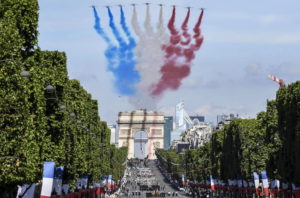
Bastille Day in French is La Fête Nationale or Le Quatorze Juillet. This is the most important date in the French calendar, and is marked with a large military parade, Eiffel Tower concert and fireworks. This year there will be a concert at 12 noon at the Champs de Mars, and a host of other events in celebration of France’s history and heritage. One of the best places to be in the evening is along the banks of the Seine, where you can try and find a great spot to enjoy the fireworks from the Eiffel Tower.
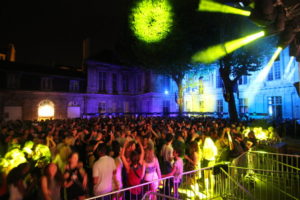
The French adore their pompiers (firemen), and each year a highly popular event that coincides with Quatorze Juillet celebrations are the Bals des Pompiers (Fireman’s Balls), held on 13 and 14 July. These are held at a number of fire stations across the city, where it’s open house, with dancing drinking and plenty of merriment. Paris at its most atmospheric.
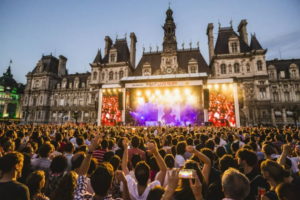
Another summer treat in Paris is the extravagant Paris L’été, or Paris Summer Festival. Think open-air theatre, music performances, grand circuses, to name a few. This is the ultimate celebration of French arts, freedom, culture, and beauty. Spread over different venues in the city, Events are mostly free (or a small, nominal charge), which makes it a huge hit amongst visitors and locals alike. Held for over 20 years now, this beautiful festival gives a platform to over 70 artists and takes festivals of France to another level. Dates for 2022: 21 June to 23 September.
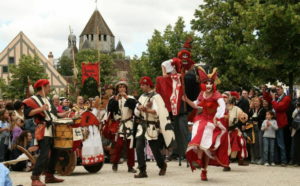
“The biggest medieval festival in France” is how the organisers describe the festival of Les Médiévales de Provins. That’s a bold claim, but when you see the knights, damsels, dancers, musicians, minstrels, acrobats, troubadours, fire-eaters, and jousters that bring this joyous festival alive every summer, you might think that it’s no overstatement. The festivities include a concert, a ball and parade of over 700 participants in medieval costume through the streets of this beautiful UNESCO World Heritage medieval town. Provins is easily accessible from Paris, and you can use your Navigo transport pass to get there. This year, date of the festival was the weekend of 25 – 26 June.
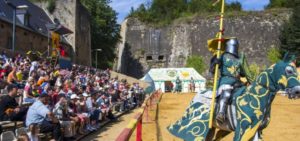
Another medieval festival that always makes the Top 10 list is the Festival Médiéval de Sedan in 2022 on the weekend of 14-15 May. Held at the largest medieval castle in Europe, the Château de Sedan, the festival brings the spirit of the Middle Ages alive. Exciting jousting tournaments, sumptuous banquets and atmospheric parades take place around the château grounds. The château itself is spread over 7 floors across 35,000 sq.m., and there’s certainly lots to see. Just be prepared to climb lots of stairs.
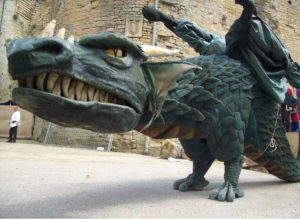
There is a wide variety of entertainment in the grounds and out on the town’s streets. These include a magnificent procession of knights, nail-biting sword flights and wrestling matches, falconry shows, cross-bow demonstrations and flag-throwing competitions. Some of the festival highlights include a parade by torchlight across the château grounds, a dragon-slaying performance, and a medieval market. The château and town are located in northern France in the Ardennes region, 10kms from the Belgian border, and about 200kms from Paris.
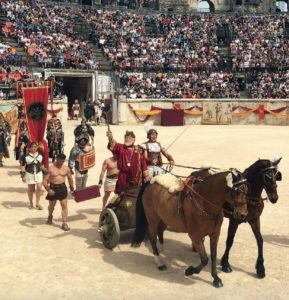
Want to step even further back in time? Head to the UNESCO World Heritage town of Nîmes in Provence for The Great Roman Games. Over a weekend in April or May each year, Roman legionaries, an Imperial court, riders, and battle chariots take over the city to participate in the biggest and most spectacular re-enactments of ancient history in Europe. Over 500 actors and extras from all over France, Italy and Germany take part. A grandiose spectacle lasting an hour and ½ takes place in the splendidly preserved Roman arena on Saturday and Sunday afternoon. Built around 70AD to celebrate the reign of the Emperor Augustus, who died in 14AD, the elliptical arena has a capacity of 24,000 people, and is one of the great sights of Roman-era France.
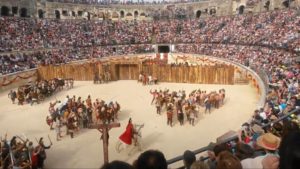
Although most of the events take place in the arena, there’s some spill-over games that are held nearby. Each year the great Roman Games has a different theme, selected to highlight an historical event, for example, Hannibal, Cleopatra, the assassination of Julius Caesar and so forth. The spectacle features equestrian vaulting demonstrations, parade of Pretorian Guards, gladiatorial combats, and chariot racing. There’s plenty of free entertainment in the city centre: reproduction historic costume parades, guided tours of the archaeological museum and the magnificent Maison Carrée Roman temple, a Roman weapon-handling workshops for children, or perhaps visit an ancient Roman fashion show.
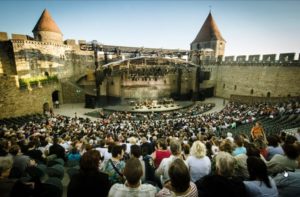
As if the picture perfect medieval castle wasn’t enough, the UNESCO World Heritage Site of Carcassonne takes things up another notch in July with its annual Festival de Carcassonne. Famous national and international stars converge to present over 120 performances, 80 of which are entirely free, take place on the ramparts and narrow streets throughout the walled town, including opera, dance, rock and pop, and theatre at two equally atmospheric venues. The whole town is transformed into an international stage and welcomes more than 200,000 spectators who come to the shows and to marvel at the Cité’s 1,000 year old crenellated ramparts and narrow streets lit up for the festival, against a backdrop of a blue, starry night. The variety and diversity of the events make this festival one of the great French festivals, and one of the most important cultural events in the Grand Sud in July. It has been described as the place where history and arts mix to create a beautiful symphony.
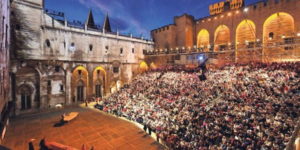
If you’re a fan of live theatre, a fantastic French festival not to miss is the Festival d’Avignon. The annual theatre festival is held over 3 weeks in July at 40 locations in the town, which transforms its architectural heritage into various majestic performance venues, one of which is the Cour d’Honneur (courtyard) of the Palais des Papes. Founded in 1947, the festival stages 300 performances of 50 different shows by some 30 companies from all over the world, who descend on this picturesque corner of Provence bringing the very best in contemporary theatre, and making it the largest international festival of live performances. Tens of thousands of theatre-lovers of all ages go to enjoy theatre, dance, visual arts, live music, lectures, workshops, exhibitions, and cinema.
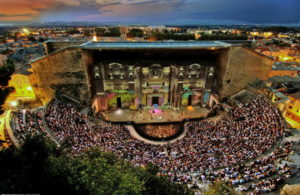
Dating back to 1869, the Chorégies d’Orange is the oldest festival in France, and the place to be if you love opera and other forms of classical music. It takes place every year in August in venues across the town of Orange, but the big attraction is the beautifully preserved Roman theatre with seating for 9,000 spectators, who have come to lap up the incredible atmosphere and the exceptional natural acoustics created by the theatre’s original stone stage wall. With its semi-circular tiered stone seating, it’s undoubtedly one of the best settings in the world in which to enjoy al fresco music. Every year, the program comprises works of well- and lesser-known productions starring international opera stars. Many major players of the French and international classical stage have appeared in the Orange festivals over the years, and tickets can sell out well in advance, so book as early as you can.
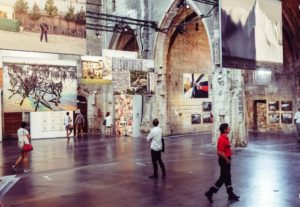
If you have a particular interest in photography, the Provençal town of Arles is the place to go during the summer months of July – September. Said to be the biggest such festival in the world, Les Rencontres d’Arles is to photography what Cannes is to cinema, and offers a program of eclectic and contemporary art, from documentary to conceptual and fine art: one week full of events and two months of exhibitions throughout the city. Launched in 1969, every year it marks a high point for photographers and marks Arles out as an international capital of photography. Some 60 exhibitions are set up around emblematic sites of Arlesian heritage, including places that are usually closed to the public and which are thus brought back into the community’s awareness.
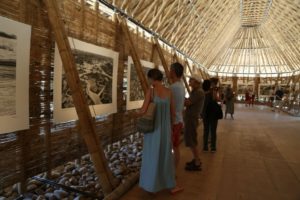
Les Rencontres were the first to organise an exhibition in the old Arles railway workshops, and some sites such as 12th century chapels, that are open to the public only for the duration of the festival. Les Rencontres organise open air night projections at the Roman Amphitheatre, a unique international event. Every evening a photographer or photography specialist presents photographs sometimes accompanied by a concert or performances, focusing on a different subject every evening. The compact nature of Arles and its intimate scale mean that Les Rencontres have remained easy and enjoyable to navigate.
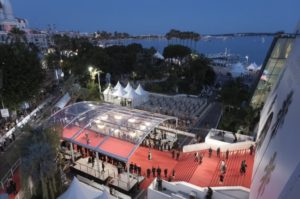
Head to the Riviera for the Cannes Film Festival (Festival de Cannes), held over 12 days in May each year. Arguably the most prestigious film festival in the world, it was founded in 1946. Famous film directors are usually designated as Presidents of the Jury and the highest prize awarded is the prestigious Palme d’Or (Golden Palm). You normally have to be a part of the film industry to attend the various official events and film previews. However, mere mortals are allowed at the open-air beach cinema (Cinéma de la Plage) where a different film is shown every night. And then of course there’s always the chance to go movie-star spotting.
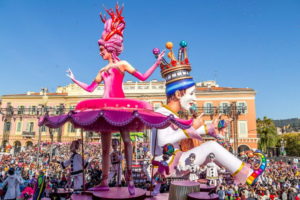
Taking place every February, the famous Carnaval de Nice is one of the largest in the world, alongside those in Brazil, Venice, and Mardi Gras in New Orleans. Many people regard it as the most important event on the French Riviera. Over 1 million people take to the streets of Nice during the day and night. They come to marvel at the flamboyant floats, colourful costumes, and stunning parades, all the while soaking up the buzzing Carnival atmosphere. More than 1,000 dancers and musicians from around the world perform at this magnificent event.
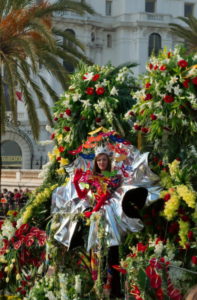
Each year, a special theme is chosen, and artists create a series of floats and other figurines in papier-mâché for the colourful parade. Once night falls, the floats are illuminated for the enchanting Parade of Lights. A vibrant Battle of Flowers is a parade of around 20 floats that also takes place each year, when extravagantly dressed characters throw 100,000 flowers into the crowd along the Promenade des Anglais. Clouds of confetti and colourful string also fill the air adding to the excitement.
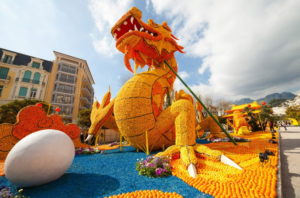
Further along the coast on the border with Italy, Menton is the most Italianate and warmest town along the Riviera, home to one of France’s most unusual and picturesque annual festivals. Held over two weeks in February, the Fête du Citron celebrates all things citrus in the town of Menton. More than 230,000 visitors come to marvel at the colour floats and sculptures created from lemons and oranges. During the daytime, parades of fruit-covered floats make their way through the streets, as wind musicians, acrobats and drummers entertain the crowds.
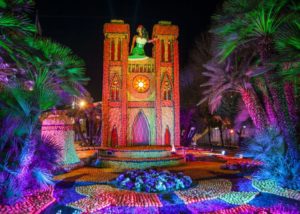
The evening sees 20m high whimsical statues and models made from citrus fill the picturesque, Jardins Biovès and Palais de l’Europe, illuminated with a magical sound and light show. Don’t forget to visit the Crafts Fair and the Festival of Orchids, redolent with unforgettable scents.
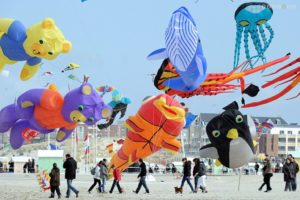
Who says pigs can’t fly? If you go to the Berck-sur-Mer International Kite Festival, you may well see such phenomena! This spectacular display of kites fly over the seaside town of Berck-sur-Mer, in the northern French department of Pas-de-Calais on the so-called Opal Coast. This charming little gem of a town lies next to the well-known Le Touquet, within the Marquenterre regional park, an ornithological nature reserve. The clean, sandy beach runs for 12 kms., and it’s an ideal location for sand yachters, walkers, and of course, kite flyers.
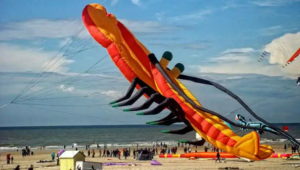
Taking place every Easter, the festival sees giant dragons, whales, octopuses, various cartoon characters, and the occasional very large pig, take to the skies over the sandy beach. During the festival, experts from all over the world compete against the wind—and each other, and the best 10 individual pilots compete for the Champion’s Cup. There is plenty of space up on the sand dunes to get a good view of the spectacle, and also lots of activities and entertainment. Children can learn how to make and fly kites or shop for their very own kite among the many stalls. It’s worth staying for the last evening of the festival, when a night-time display and fireworks show bring the majestic event to a close.
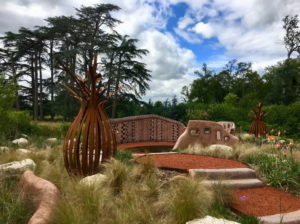
Since 1992, the International Garden Festival at the Domaine de Chaumont-sur-Loire has been a laboratory for contemporary garden and landscape design worldwide. Every year, the festival exhibits over 30 themed gardens and has had contributions from the UK, Japan, the Netherlands, Germany, and Italy. The gardens are particularly enthralling during the evening of the summer months, as the whole place glows with over 2,000 candles, enhancing the beauty of the fascinating exhibits and collections.
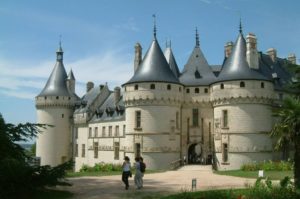
This year, the festival runs from 25 June to 02 October, but the dates vary somewhat each year. Chaumont-sur-Loire is in the town of Montrichard, part of the district of Blois in centre of the Loire Valley, and less than 200kms south of Paris. Each year the festival has a theme, which in the past has ranged from historic, poetic, education and ecology and this year, the topic has been “the ideal garden.” Expect to see gardens as artworks, a nourishing vegetable garden, a therapeutic space, a showcase for organic cultivation, water conservation, energy efficiency, and much more.

For four evenings in December, the city of Lyon comes aglow during the Fête des Lumières (Festival of Lights), which pays homage to the Virgin Mary, on the Feast of the Immaculate Conception. Thousands of flickering candles can be seen in windows and on balconies, creating a beautiful, magical atmosphere. The Festival developed from a tradition dating back to 1852, and by the 1960s, there were shop window illumination competitions, especially among Lyon’s famous food shops, to mark the start of the Christmas season.
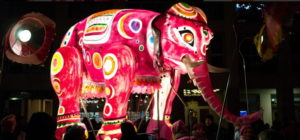
In 1989, thanks to an avant-garde public lighting policy, Lyon adopted its first Plan Lumière. The city now sponsors spectacular lighting displays, and this year there will be around 30 of these high quality productions, some large, some more intimate, combining installations or displays. These projects embellish the city’s squares, streets, bridges, riverbanks, and the two rivers themselves. The Festival reveals the heritage of the Presqu’île and Vieux Lyon in its best possible light, illuminating its Renaissance façades and majestic buildings. The City says that the object of the Festival is to celebrate and showcase its living heritage. The event will take place this year from Thursday 08 December to Sunday 11 December.
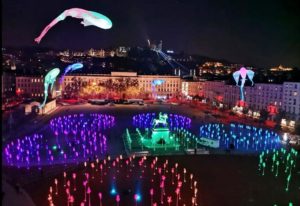
When you’re planning your next visit to France, check out these and the many other festivals scattered throughout the country. These special events are great ways to experience the unique magic of some extraordinary venues such as enormous Roman arenas or World Heritage Sites. Whether you’re just heading to Paris or exploring some of the regions and smaller destinations, a special festival is a great way to enhance your trip. Just be sure to organise your accommodation well in advance!


As always – fascinating and so much research!
Love the Parisplus!
Bonjour Cheryl
Thank you for that extensive review of the Festivals of France. I had no idea there were so many and so diverse.
Each festival you described has ones mouth watering as to where to go and when?
Your Paris plus plus blogs keep us wanting more and more.
Merci beaucoup
Pam B
Thanks Cheryl . I will bear in mind for next year .
Hi Lois,
Far too many to mention in just one story, so this is just a sample!
Cheers,
Cheryl